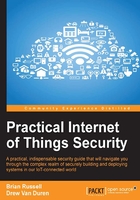
The IoT of the future and the need to secure
While today's IoT innovations continue to push the envelope identifying and establishing new relationships between objects, systems, and people, our imaginations continuously dream up new capabilities to solve problems at unprecedented scale. When we apply our imaginative prowess, the promises of the IoT becomes boundless. Today, we are barely scratching the surface.
The future – cognitive systems and the IoT
The computer-to-device and device-device IoT is poised for staggering growth today and over the coming years, but what about brand new research that is on the brink of consumerization? What will need to secure in the future, and how will it depend on how we secure the IoT today? Cognitive systems and research provides us a valuable glimpse into the IoT of tomorrow.
Over a decade ago, Duke University researchers demonstrated cognitive control of a robotic arm by translating neural control signals from electrodes embedded into the parietal and frontal cortex lobes of a monkey's brain. The researchers converted the brain signals to motor servo actuator inputs. These inputs allowed the monkey — through initial training on a joystick — to control a non-biological, robotic arm using only visual feedback to adjust its own motor-driving thoughts. So-called brain-computer interfaces (BCI), or brain-machine interfaces (BMI), continue to be advanced by Dr. Miguel Nocolelis' Duke laboratory and others. The technology promises a future in which neuroprosthetics allow debilitated individuals to regain physical function by wearing and controlling robotic systems merely by thought. Research has also demonstrated brain-to-brain functioning, allowing distributed, cognitive problem-solving through brainlets.
Digital conversion of brain-sensed (via neuroencaphalography) signals allows the cognition-ready data to be conveyed over data buses, IP networks, and yes, even the Internet. In terms of the IoT, this type of cognitive research implies a future in which some types of smart devices will be smart because there is a human or other type of brain controlling or receiving signals from it across a BMI. Or the human brain is made hyper-aware by providing it sensor feeds from sensors located thousands of kilometers away. Imagine a pilot flying a drone as though it were an extension of his body, but the pilot has no joystick. Using only thought signals (controls) and feedback (feeling) conveyed over a communications link, all necessary flight maneuvers and adjustments can be made. Imagine the aircraft's airspeed, as measured by its pitot tube, conveyed in digital form to the pilot's BMI interface and the pilot "feeling" the speed like wind blowing across his skin. That future of the IoT is not as far off as it may seem.
Now imagine what type of IoT security may be needed in such cognitive systems where the things are human brains and dynamic physical systems. How would one authenticate a human brain, for example, to a device, or authenticate the device back to the brain? What would digital integrity losses entail with the BMI? What could happen if outgoing or incoming signals were spoofed, corrupted, or manipulated in timing and availability? The overarching benefits of today's IoT, as large as they are, are small when we consider such future systems and what they mean to the human race. So too are the threats and risks.